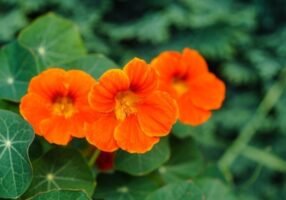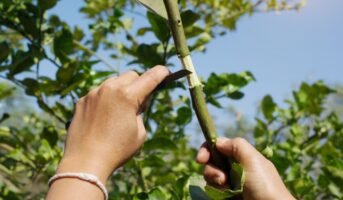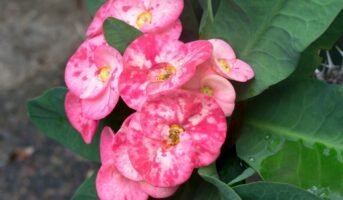Asters or Aster amellus are members of the daisy family and typically bloom in the late summer and fall, earning them the nickname “Michaelmas daisy.” Asters bloom beautifully in mixed borders with grasses and other prairie-style perennials. Due to its perennial nature, it will continue to grow without needing to be transplanted. This flowering plant is a favorite of many gardeners due to its unusual season and capacity to reappear independently. The numerous spherical, wrinkled black seeds adhere to the walls of the expansive central chamber.

Source: Pinterest
Aster flower: Key facts
| Name Of Species | Aster amellus |
| Taxonomic Tree | Domain: Eukaryota
Kingdom: Plantae Phylum: Spermatophyta Subphylum: Angiospermae Class: Magnoliopsida |
| Family Name | Asteraceae |
| Common Name | Michaelmas daisy, Starworts, or frost flowers |
| Division Of The Plant | Angiosperms (Seed Plants) |
| Mode of Nutrition | Autotrophic |
| Native Habitat | Terrestrial, Forest edges, woodlands (Full sun to partial sun location in loamy, well-draining soil) |
| Desirable Plant Features | Bright petals arranged like a Starburst, surround a yellow center |
| Landscape Uses | Outdoor and also indoor Plant |
| Temperature | At day temperature is between 20°C – 30°C, At night temperature, is between 15°C – 17°C |
| Blooming Time | Late-summer and early-fall |
Aster flower: Description
In Greek, the word “aster,” meaning star, is derived from the goddess Astraea. Therefore, the flower is called Aster because it resembles a star’s blooms. It serves as a flower that blooms in September. This herb with daisy-like petals that bloom in the fall symbolizes love, wisdom, faith, bravery, and color. The Aster flower blooms in lilac, mauve, pink, red, and white with a brilliant bright yellow core.
Asters grow on multi-stemmed bases, reaching heights of 6 inches to 6 feet and spreading out to a width of 1 to 3 feet. Asters typically bloom in the late summer or early fall, adding a burst of color to gardens in the late summer and early fall. A favorite of gardeners, asters are also attracted by butterflies and bees.
A capitulum is the name of the aster flower. Although it appears to be a single flower from far away, it is a cluster of blossoms. Pollinators are attracted to the capitulum’s bright yellow core. Aster flowers typically have long, thin petals resembling sun rays. The outline of an aster flower resembles a brilliant, multipoint star. Petal layers in asters can be single or numerous. When crushed, it releases a smell resembling balsam.
Aster plant: Anatomy
- Plant Height: Maximum 24 inches
- Stem: The stems might be smooth or hairy, green or brown, and occasionally woody.
- Root: Aster root looks like a clump of spaghetti because it is purple and stringy.
- Leaf: Simple leaf (i.e., lobed or unlobed but not separated into leaflets). Green foliage has unusual qualities such as hairy or smooth, deeply serrated or soft edges, broad or narrow, heart-shaped, or becoming bronze in the fall.
- Flower:1.5-inch blossoms. Asters are incredibly intricate blooms. An aster flower is a cluster of highly tiny tubular blooms that are arranged in a central disc and encircled by so-called ray flowers or petals, like sunflower petals. The ring of ray flowers encircles the main disc of blooms on asters.
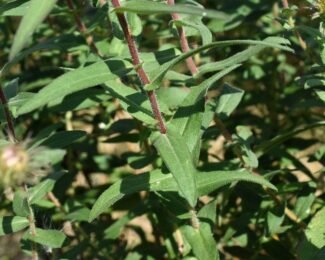
Source: Wikipedia
The flower head has strap-shaped ray flowers around the periphery and tubular disc flowers in the center.
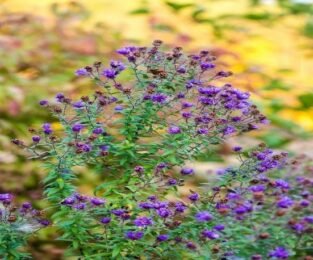
Source: Wikipedia
see also about: Moringa tree
Aster flower: Colours and symbolism
The aster flower comes in various hues, each of which denotes a particular symbol.
- Purple asters are the most common color and stand for wisdom and majesty.
- White asters stand for innocence and purity.
- Red asters stand for unwavering commitment.
- Pink asters stand for tenderness and love.
Varieties of Aster plants
New England and New York perennial asters are the two most popular varieties. Since there are various variations, it might be challenging to distinguish between them. New York asters typically have smooth leaves, thin stems, and shorter statues. Asters from New England will grow taller and bushier, with thick stems and hairy leaves. Specific “wild type” native species are the sensible choice for the ecologically conscious gardener. In addition, several hybrid types are available in vibrant colors.
Habitat and distribution of Aster flower
In addition to sub-alpine meadows, marshy areas, and lake shores, the usual habitat includes rocky, limy regions, the borders of shrubs and corpses, and more. It favors basic pH, calcareous, slightly dry, poor nutritional value substrate at an altitude of 0-800 meters (0-2,625 ft) above sea level.
The Pyrenees, Alps, and Carpathians in Europe all have this shrub growing there. Outside of Europe, it can be found in Central Asia (Uttarakhand, India), South Asia (South Asia, Siberia), Western Asia (Turkey), and the Caucasus (Kazakhstan).
Aster flowers and their cultural meaning
The ancient Greeks regarded the aster flower as being of great benefit. Around the house, they were thought to frighten off snakes and evil spirits.
A ceremonial ritual of laying asters on the graves of French soldiers during World War II. They did this to imply that they wished the soldier’s situation had been different. Asters have appeared in numerous works of art, such as literature and paintings.
How to grow and care for Aster flowering plants?
Asters are low maintenance and easy to grow. They can be grown from seeds or bought as potted plants. Here’s all about growing and maintaining Aster plants.
Where to plant Asters?
Asters prefer areas with moist, cool summers and cool nights, with partial to full sunlight. Asters do not like the scorching midday sun in warmer climates. Make sure the soil is moist but well-drained and loamy as dry sandy soil will cause plant wild and wet clay soil can result in root rot. Add 2-3 inches of compost in the soil before you plant.
When to plant Asters?
The best time to plant Asters in the ground is between mid- and late-spring after the frost has passed. You can also choose to plant mature, potted Asters, which usually become available in early fall or late summer. Asters can be planted from seeds. However, in such cases, germination can be uneven. If you want, you can plant seeds in the fall and keep them indoors during winter.
How to plant Asters?
Follow the steps given below to plant Asters:
- To plant young Asters outside in springs, space them around 1-3 feet apart, based on their type and the size they are expected to grow to.
- If you are planting fully-grown Asters, plant them around 3 feet apart.
- If you’re planting seeds, sow them 1 inch deep in pots and refrigerate them for 4-6 weeks to stimulate winter dormancy. This will start the process of germination.
- Water them well and spread mulch around them to prevent weeds and keep the soil cool.
How to care for Asters?
Here are some tips to care for and maintain Asters:
- Add a portion of balanced fertiliser or a thin layer of compost with a 2-inch layer of mulch around Asters every spring to promote growth.
- Water regularly during summers, if there is less than 1 inch of rainfall per week. Keep in mind that most Asters are sensitive to too little or too much moisture. This can cause problems in flowering and lower foliage. If you observe stress or flower loss, change the watering method.
- Stake taller Asters to prevent them from falling over.
- Pinch them by one-third once or twice during early summers to encourage more blooms and bushier growth.
- Cut them back after the foliage has died in winters.
- Divide Asters every 2-3 years during spring to maintain their vigour and flower quality.
Propagation of Asters
Start with seeds, soft stem cuttings, divisions, or nursery plants to cultivate your perennial Asters that bloom in the fall.
Propagation from seeds
Many varieties of Asters self-seed. You can also collect the mature seeds to plant them in your desired locations. These mature seeds resemble white or light brown puffballs, like a dandelion seed. Also, each of these seeds has a tiny “parachute” to catch the wind. Remember that the seeds produced by your Aster can grow into a plant that appears completely different from the parent plant.
Propagation from division
Once some Asters have grown into a large clump, use a shovel to divide the clump into two or more parts every three years. Dig up the cut parts and quickly plant them into the desired location. Feed the new planting with a low-nitrogen fertiliser or a phosphorous source like rock phosphate or bone meal.
Propagation from cuttings
You can propagate some varieties of Aster by taking softwood cuttings. Make sure to perform this kind of propagation in spring. Cut a 3-5 inch section of the step, remove the lower leaves, and keep 3-4 upper leaves. Root the cutting in perlite or sand and cover it with a clear plastic bag to retain moisture. Provide the cutting with light and water until it forms roots, before transplanting it to a small pot.
Aster: Interesting facts
- The birth flower for September is the Aster.
- The crushed foliage and flowerheads smell like balsam.
- The Germanic tribes though the scent of burning leaves from wilting asters drove away venomous snakes and terrible spirits for the winter.
- Asters are well renowned for withstanding drought and are excellent for desert landscaping.
- Bushy aster species produce seeds resembling parachutes carried by the wind.
- The Aster genus, which belongs to the same family as the daisy, has more than 600 species.
- Asters are composite flowers whose long petals encircle a center core of numerous tiny blossoms.
Aster flowers: Benefits and uses
Plants and flowers have been utilized worldwide for several purposes over time. In various cultures, there have been and still are a variety of purposes for plants, including medical, nutritional, and ornamental ones.
Medicinal uses
- The blooms are suitable for the lungs and promote respiratory health. A tincture from this flower can help people with chronic lung diseases like asthma and flu.
- The aster plant was used to treat venereal disease in several cultures. Other civilizations have utilized the aster root in Chinese medicine for ages. They treat buboes, or swellings of the lymph nodes, with seeds, foliage, and flowers.
- The root can act as a laxative and helps to lessen headache discomfort. It has been used to cure other conditions, such as soft skin, pain, fevers, hangovers, and epilepsy.
- Use them as amulets to stave off alleged threats, making a salve from the leaves and axle grease to cure dog and snake bites.
Dietary
Aster plant parts can be used as garnish or salad greens because the leaves and blooming tips are edible. In addition, it is possible to make tea or tincture from several plant parts, including the root, leaves, and flowers.
Nutritional benefits
Aster leaves provide a significant amount of protein and B vitamins, including thiamin and niacin. They also include beta-carotene and riboflavin and are high in vitamin C. In addition, the leaves have a large amount of fiber and significant amounts of minerals, calcium, phosphorus, iron, and potassium.
Environmental use
Numerous pollinating insects are attracted to asters in the late season. They provide food and habitat for various birds and small animals during the winter, who eat the seeds and find shade in the dried stalks.
Decorative use
Asters commonly called “Enchanted flowers,” are frequently used to create festive bouquets for birthdays and anniversaries.
Recognising typical Asters issues
There are several typical aster pests and diseases that, if ignored, can cause issues.
- Rust and powdery mildew are among the examples. Fungicides are a viable treatment option.
- Other, more severe illnesses that can cause a plant’s death include root rot, wilt, and foot rot. Asters should only be planted in well-draining soil to prevent breakdowns. Plant only wilt-resistant cultivars to avoid it. And botrytis blight also kills that blooms.
- Blight usually forms when the plants are damp, this may be avoided by carefully watering the plants.
Invasiveness and control
All asters can grow. They are boisterous plants that proliferate by rhizomes that grow underground. Although they rarely cause issues in the garden and provide a fantastic ground cover, they can occasionally get extremely weedy and spread in dry places like pine woods, scrub, and deserts.
The best way to handle Aster is by pulling with your hands. It is easy to remove while the earth is damp. However, manual control might not be feasible if the Plant has a far spread. In this situation, it could be necessary to use a post-emergent herbicide made especially for broad-leaved Plants.
Aster flower: Toxicity
The flowers of China Aster are edible and not at all toxic to humans. They also don’t pose any danger to animals. However, since there are so many diverse species of Asters and since they can be easily confused with poisonous chrysanthemums, it’s advisable to only eat them if you can identify these flowers with absolute certainty. All in all, Asters are absolutely safe to plant in your home garden.
Aster flowers are common flowers with a variety of symbolism and meaning in addition to their beauty. Asters resemble stars and can evoke a joyful emotion when presented as gifts for various occasions.
Asters may give a pop of color to a fall bouquet and are ideal for birthdays, wedding anniversaries, or other private gatherings. Even after other flowering plants have completed blooming, these vibrant blossoms can be found in an outdoor gardening area later in the growing season.
FAQs
Do asters need to be deadheaded?
With asters, careful pinching and thinning are simple and fantastic for encouraging robust plants and lots of blooms. Throughout the growing season, deadheading spent blooms can also whip up additional blossoming.
Do asters regrow each year?
Asters are perennials, meaning they will grow back year after year, provided they are planted in a sunny location with free-draining soil.
Do asters need fertilizer?
Asters would benefit from a thin dusting of compost in the spring or two applications of a balanced flower fertilizer every two weeks starting in the spring and continuing until the blooms begin to open.
What insects are drawn to toasters?
Heart-leaved aster flower heads are a popular food source for a wide variety of insects, including wasps, flies, butterflies, skippers, and beetles.
Has the aster flower been used for medical purposes?
The Iroquois used Aster, bloodroot, and other healing plants to create a laxative. To treat headaches, the Ojibwa applied a topically applied aster root infusion. The flower's parts were also utilized to treat genital illnesses.
Housing News Desk is the news desk of leading online real estate portal, Housing.com. Housing News Desk focuses on a variety of topics such as real estate laws, taxes, current news, property trends, home loans, rentals, décor, green homes, home improvement, etc. The main objective of the news desk, is to cover the real estate sector from the perspective of providing information that is useful to the end-user.
Facebook: https://www.facebook.com/housing.com/
Twitter: https://twitter.com/Housing
Email: [email protected]

